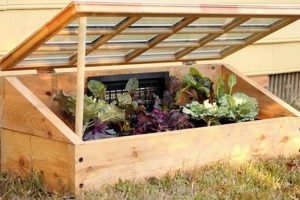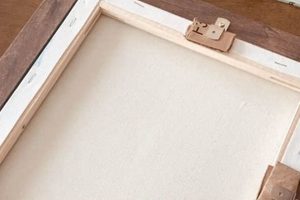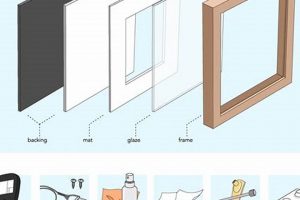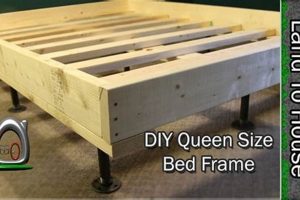Structures created at home to support a mattress are known as self-constructed sleeping platforms. These platforms can range from simple designs using reclaimed wood to more elaborate projects incorporating metalwork and integrated storage. An example is a platform built from repurposed pallets, providing a rustic aesthetic.
Creating one’s own sleeping platform offers several advantages, including cost savings, customization options, and a sense of accomplishment. Historically, constructing furniture at home was a necessity, and this practice continues today as a form of creative expression and resourcefulness, allowing for the tailoring of sleeping arrangements to specific needs and spatial constraints.
This discussion will now explore various approaches to constructing such platforms, examining material choices, design considerations, and essential techniques for ensuring structural integrity and aesthetic appeal.
Construction Tips for Self-Made Sleeping Platforms
Effective construction of a sleeping platform requires careful planning and execution. The following tips offer guidance on ensuring a structurally sound and aesthetically pleasing result.
Tip 1: Material Selection is Critical. Choose lumber that is appropriately graded for structural use. Softwoods like pine are cost-effective but may require additional support, while hardwoods such as oak offer greater strength and durability. Consider reclaimed materials for environmental and aesthetic reasons, but verify their structural integrity.
Tip 2: Accurate Measurements are Essential. Measure the mattress dimensions precisely and factor in a slight allowance for bedding. Inaccurate measurements can lead to an ill-fitting platform, compromising comfort and stability.
Tip 3: Proper Joinery Techniques Enhance Durability. Employ robust joinery methods such as mortise and tenon, dowel joints, or pocket screws to securely connect the frame components. Weak joints can lead to instability and eventual failure.
Tip 4: Reinforcement Increases Stability. Add corner brackets, center supports, and crossbeams to reinforce the frame and prevent sagging, especially for larger platforms or heavier mattresses. Metal reinforcements provide superior strength.
Tip 5: Sanding and Finishing Improve Aesthetics and Safety. Smooth all surfaces with sandpaper to eliminate splinters and sharp edges. Apply a sealant or finish to protect the wood from moisture and enhance its appearance. Non-toxic finishes are preferable for sleeping surfaces.
Tip 6: Leveling Ensures Stability. Ensure the platform is perfectly level by using shims or adjustable feet. An uneven surface can cause discomfort and strain on the frame.
Tip 7: Headboard and Footboard Integration. Plan for the integration of a headboard and footboard early in the design process. These elements can add aesthetic appeal and provide additional support.
Following these tips will contribute to a solid, functional, and visually appealing sleeping platform. Prioritizing structural integrity and attention to detail will ensure a durable and comfortable addition to the sleeping space.
The next section will address common design options and stylistic considerations for these self-constructed structures.
1. Materials Strength
The structural integrity of self-constructed sleeping platforms is fundamentally dependent on the strength and suitability of the selected materials. The choice of materials directly impacts the longevity, stability, and safety of the completed structure.
- Load-Bearing Capacity
The capacity of the materials to withstand the weight of the mattress and occupants is a primary consideration. Different materials exhibit varying degrees of resistance to bending and compression. For instance, softwood lumber, while readily available and cost-effective, may require additional bracing to prevent sagging under load. Hardwoods, such as oak or maple, offer superior load-bearing capabilities, reducing the need for extensive reinforcement. The selection should be based on anticipated weight and desired platform dimensions.
- Joint Integrity
The strength of the materials also affects the integrity of the joints connecting the frame components. Weak or brittle materials may be prone to splitting or cracking at stress points, compromising the overall stability of the platform. Using appropriate joinery techniques, such as mortise and tenon or dowel joints, can mitigate this risk, but the underlying material strength remains a critical factor. The type of joint must be compatible with the selected material to ensure a secure and lasting connection.
- Resistance to Deformation
Over time, materials can deform under sustained pressure, leading to warping or sagging. The choice of material influences the platform’s resistance to these effects. Materials with a high modulus of elasticity, indicating greater stiffness, are less likely to deform under load. Selecting materials with inherent resistance to moisture and temperature fluctuations further enhances their ability to maintain their shape and structural integrity over time. This is particularly important in environments with high humidity or significant temperature variations.
- Durability and Longevity
The inherent durability of the material impacts the lifespan of the sleeping platform. Materials susceptible to rot, insect infestation, or decay will require more frequent maintenance or replacement. Selecting treated lumber or naturally durable species can extend the lifespan of the platform. Proper sealing and finishing can also enhance the material’s resistance to environmental factors and prolong its structural integrity.
In summary, the selection of materials with adequate strength is crucial for the successful construction of a durable and safe sleeping platform. Considerations must encompass load-bearing capacity, joint integrity, resistance to deformation, and long-term durability. Careful evaluation of these factors ensures that the resulting structure provides reliable support and comfort for years to come.
2. Accurate Measurements
The precision of dimensions is paramount in the context of self-constructed sleeping platforms. Accurate measurements are not merely a preliminary step but a foundational element upon which the structural integrity, functionality, and aesthetic appeal of the finished platform depend.
- Mattress Compatibility
The primary function of a sleeping platform is to support a mattress. Discrepancies between the platform’s dimensions and those of the mattress result in an ill-fitting and potentially unstable sleeping surface. A platform that is too small will leave the mattress unsupported, while a platform that is too large may allow the mattress to shift excessively. Standard mattress sizes, such as twin, queen, or king, provide a starting point, but precise measurements are essential to account for variations in mattress thickness and overall dimensions. Deviations, even small ones, can compromise comfort and structural stability.
- Material Calculation and Cost Efficiency
Accurate measurements are indispensable for calculating the quantity of materials required for the project. Imprecise dimensions lead to inaccurate material estimates, resulting in either material shortages or costly overages. By precisely measuring the intended platform size, builders can optimize material usage, minimize waste, and reduce overall project expenses. This is particularly relevant for projects involving expensive lumber or custom-ordered components.
- Structural Stability and Load Distribution
The structural integrity of a sleeping platform relies on precise alignment and load distribution. Inaccurate measurements can result in uneven weight distribution, placing undue stress on certain joints or components. This, in turn, can compromise the platform’s stability and increase the risk of failure. Precise dimensions ensure that the load is evenly distributed across the frame, enhancing its overall strength and durability. For example, diagonal measurements are crucial for ensuring a perfectly square frame, which is essential for uniform load distribution.
- Aesthetic Consistency and Visual Harmony
Beyond functionality, accurate measurements contribute to the aesthetic appeal of the finished platform. Precise dimensions ensure that the platform aligns with the intended design and complements the surrounding space. Inconsistencies in measurements can result in a visually disjointed or unbalanced appearance. Attention to detail, including precise measurements of all components, is essential for achieving a polished and professional-looking final product.
In conclusion, the significance of accurate measurements in the context of self-constructed sleeping platforms extends beyond mere dimensional accuracy. It encompasses mattress compatibility, material efficiency, structural stability, and aesthetic consistency. Diligence in this initial phase is essential for ensuring a durable, functional, and visually pleasing outcome, ultimately contributing to a comfortable and secure sleeping environment.
3. Robust Joinery
The structural integrity of self-constructed sleeping platforms is fundamentally linked to the employment of robust joinery techniques. The connections that unite the individual components dictate the overall stability and load-bearing capacity of the structure. Deficient joinery is a primary cause of premature failure in these projects, leading to instability and potential safety hazards. Conversely, well-executed joinery ensures that the platform can withstand the stresses imposed by weight and movement, extending its service life. Examples of robust joinery include mortise and tenon joints, dovetail joints, and precisely executed bolted connections. These methods distribute stress evenly across the joint, minimizing the risk of localized failure. Understanding the principles of effective joinery is thus of paramount practical significance for those undertaking such construction projects.
Consider the practical application of these principles. A basic butt joint, while simple to execute, offers minimal resistance to shear forces and tensile stress. In contrast, a mortise and tenon joint, where a projecting tenon from one piece of wood is fitted into a mortise (hole) in another, provides a significantly stronger connection. This type of joint is commonly employed in crafting bed frames designed to withstand substantial weight and repeated use. Similarly, the use of metal fasteners, such as bolts and screws, can be strategically combined with traditional joinery techniques to enhance the strength and security of the connections, particularly in areas subject to high stress. The choice of joinery technique should be carefully considered based on the anticipated loads and the properties of the materials employed.
In summary, robust joinery is not merely a stylistic consideration but a critical determinant of the longevity and safety of self-constructed sleeping platforms. The investment in learning and implementing appropriate joinery techniques directly translates to a more durable and reliable final product. Challenges may include the complexity of certain joint types and the need for specialized tools, but these obstacles are outweighed by the long-term benefits of a well-constructed and structurally sound sleeping platform.
4. Reinforcement Strategies
The longevity and stability of self-constructed sleeping platforms are intrinsically linked to the implementation of effective reinforcement strategies. Absent appropriate reinforcement, these structures are susceptible to sagging, warping, and eventual collapse under sustained load. These issues undermine both the structural integrity of the platform and the comfort of the user. Proper reinforcement distributes weight evenly, minimizes stress on joints, and enhances the overall rigidity of the frame. Real-world examples include platforms constructed from reclaimed wood, which often necessitates additional bracing due to inherent variations in material strength. Understanding and applying these strategies is therefore critical for ensuring the durability and safe functionality of such projects.
Specific reinforcement techniques encompass a range of applications, including the strategic placement of center supports to mitigate sagging in the middle of the platform. Corner bracing is often incorporated to enhance the rigidity of the frame and prevent racking. The use of metal brackets and fasteners further strengthens joints and connections, particularly in high-stress areas. For larger platforms, the addition of crossbeams provides supplementary support, distributing weight across a wider area. The selection of appropriate reinforcement methods should be tailored to the specific design, materials used, and anticipated load-bearing requirements of the platform. For instance, a platform designed for a memory foam mattress will require different reinforcement considerations than one intended for a traditional innerspring mattress due to differences in weight distribution.
In summary, reinforcement strategies are an indispensable element in the successful construction of self-made sleeping platforms. While challenges may arise in selecting the most appropriate techniques or sourcing suitable materials, the benefits of a well-reinforced structure increased durability, enhanced stability, and improved safety significantly outweigh the challenges. The application of these strategies transforms the project from a basic assembly of materials into a robust and reliable foundation for a comfortable night’s rest.
5. Surface Finishing
Surface finishing constitutes a critical phase in the construction of self-made sleeping platforms, impacting both the aesthetic appeal and the functional longevity of the structure. The absence of appropriate surface treatment can render the platform vulnerable to moisture damage, insect infestation, and physical wear, ultimately compromising its structural integrity. Conversely, a well-executed finish enhances the platform’s resistance to these elements, preserving its aesthetic qualities and extending its lifespan. A practical example is a platform constructed from unfinished pine, which, without proper sealing, is highly susceptible to staining and warping. Surface finishing, therefore, is not merely a cosmetic consideration but an integral component of the overall construction process.
Effective surface finishing encompasses a variety of techniques, including sanding, sealing, staining, and the application of protective coatings. Sanding prepares the surface by removing imperfections and creating a smooth substrate for subsequent treatments. Sealers penetrate the wood, preventing moisture absorption and minimizing the risk of swelling or cracking. Stains alter the color of the wood, enhancing its natural grain or creating a desired aesthetic. Protective coatings, such as varnish or polyurethane, provide a durable, abrasion-resistant layer that shields the underlying wood from physical damage. The selection of appropriate finishing techniques depends on the type of wood used, the intended use of the platform, and the desired aesthetic. For instance, a platform intended for use in a humid environment may require a moisture-resistant finish, while one intended for heavy use may benefit from a more durable protective coating.
In summary, surface finishing is a critical element in the construction of self-made sleeping platforms, contributing significantly to both their aesthetic appeal and functional longevity. While the process may present challenges, such as selecting appropriate finishing products or mastering specific application techniques, the benefits of a well-protected and visually appealing platform outweigh the difficulties. Incorporating proper surface finishing techniques transforms a basic structure into a durable, attractive, and long-lasting addition to the sleeping space.
6. Level and Stability
The relationship between levelness, stability, and self-constructed sleeping platforms is fundamentally one of cause and effect. An unlevel platform, irrespective of material quality or joinery technique, inherently lacks stability. This instability manifests as uneven weight distribution, causing undue stress on specific joints and potentially leading to premature structural failure. Furthermore, an unlevel sleeping surface directly impacts user comfort, creating an uneven sleep plane that can contribute to muscle strain and disrupt sleep patterns. A common example is a platform constructed on an uneven floor, where the resulting wobble not only weakens the structure but also creates a noisy and uncomfortable sleeping experience. Thus, achieving and maintaining levelness is a critical prerequisite for ensuring the stability and long-term usability of such platforms.
The practical application of this understanding involves meticulous attention to detail throughout the construction process. Prior to assembly, the building surface should be thoroughly assessed for any irregularities. Adjustments can be made using shims or leveling feet to compensate for uneven flooring. During construction, a spirit level should be used to verify the horizontal and vertical alignment of all components. Additionally, cross-bracing can be incorporated to enhance overall stability and prevent racking. The integration of these measures ensures that the finished platform provides a solid and even base for the mattress, promoting both structural integrity and user comfort. Regular inspections for signs of settling or shifting are also essential for maintaining levelness and stability over time. Such maintenance ensures that any minor adjustments can be made before they escalate into more significant structural issues.
In summary, levelness and stability are not merely desirable attributes but essential components of well-constructed sleeping platforms. Addressing these factors proactively through careful planning, precise execution, and ongoing maintenance ensures a durable, comfortable, and safe sleeping environment. The challenges associated with achieving perfect levelness are often outweighed by the significant benefits derived from a structurally sound and stable sleeping platform.
7. Design Integration
Design integration, in the context of self-constructed sleeping platforms, refers to the seamless incorporation of structural and aesthetic elements into a cohesive and functional whole. The success of a do-it-yourself sleeping platform project hinges significantly on effective design integration; a lack thereof can result in a structurally unsound or aesthetically displeasing final product. For instance, a platform built without considering the visual balance of the room or the existing decor might clash with the surrounding environment, undermining the overall appeal of the space. Similarly, a design that fails to adequately address storage needs or ergonomic considerations can compromise the platform’s practicality. Design integration therefore ensures that the platform not only fulfills its primary function but also contributes positively to the overall environment and user experience.
Practical application of design integration involves several key considerations. Early in the planning phase, the builder should assess the specific spatial constraints and stylistic preferences of the room. This involves taking precise measurements, considering existing furniture and decor, and identifying any functional requirements, such as integrated storage or adjustable height. The platform’s design should then be tailored to address these needs and constraints, incorporating features that enhance both its functionality and its visual harmony with the surrounding space. For example, a platform designed for a small bedroom might incorporate under-bed storage to maximize space utilization, while a platform designed for a modern aesthetic might feature clean lines and minimalist detailing. The careful selection of materials, finishes, and hardware also plays a crucial role in achieving a cohesive and integrated design.
In summary, design integration is a fundamental aspect of self-constructed sleeping platforms, ensuring that the final product is not only structurally sound and functional but also aesthetically pleasing and well-suited to its environment. While the process may present challenges, such as balancing conflicting design considerations or sourcing appropriate materials, the benefits of a well-integrated design increased user satisfaction, enhanced spatial harmony, and a durable and functional structure outweigh the difficulties. The successful integration of structural and aesthetic elements transforms the project from a mere construction exercise into a thoughtful and personalized addition to the living space.
Frequently Asked Questions
The following questions address common concerns regarding the design, construction, and maintenance of self-constructed sleeping platforms. The information provided aims to clarify uncertainties and facilitate informed decision-making.
Question 1: What are the essential safety considerations when constructing a sleeping platform?
Structural integrity is paramount. The platform must be capable of supporting the weight of the mattress and occupants without risk of collapse. All materials should be free of splinters and sharp edges. Non-toxic finishes are recommended to minimize exposure to harmful chemicals.
Question 2: How does one determine the appropriate dimensions for a sleeping platform?
The dimensions should be based on the precise measurements of the mattress. An allowance of approximately one inch on each side is recommended to facilitate bedding. Accurate measurements are crucial to prevent an ill-fitting and unstable structure.
Question 3: What types of wood are most suitable for building a durable sleeping platform?
Hardwoods, such as oak or maple, offer superior strength and durability. Softwoods, such as pine, are more cost-effective but may require additional support. Treated lumber is recommended for enhanced resistance to moisture and insect infestation.
Question 4: How can sagging be prevented in a self-constructed sleeping platform?
Sagging can be prevented by incorporating center supports, crossbeams, and reinforced joints. The strategic placement of these elements distributes weight evenly and minimizes stress on the frame. The selection of appropriate materials also plays a crucial role.
Question 5: What are the recommended joinery techniques for ensuring a stable platform?
Robust joinery techniques, such as mortise and tenon, dovetail joints, or bolted connections, are essential for a stable platform. These methods provide superior resistance to shear forces and tensile stress. Proper execution of these techniques is critical.
Question 6: How does one address uneven flooring when constructing a sleeping platform?
Uneven flooring can be addressed by using shims or adjustable leveling feet. These devices compensate for irregularities in the surface and ensure that the platform rests on a stable and level base. Precise measurements are necessary to determine the appropriate adjustments.
Proper planning and adherence to established construction principles are essential for a safe and functional sleeping platform. Consulting with experienced carpenters or engineers may be beneficial for complex designs.
The following section will delve into case studies of successful and unsuccessful self-constructed sleeping platform projects, providing valuable insights and lessons learned.
DIY Bed Frames
The preceding exploration detailed critical aspects of DIY bed frames. Structural integrity depends on material selection, precise measurements, robust joinery, and reinforcement strategies. Aesthetic considerations are addressed through surface finishing and design integration. Addressing levelness and stability ensures longevity and user satisfaction.
Successful implementation of these principles requires diligence and technical understanding. The construction of DIY bed frames should proceed with careful planning, adherence to safety protocols, and a commitment to quality craftsmanship, resulting in durable and personalized sleeping platforms.







